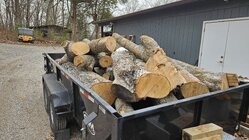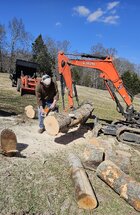For those considering taking up the hobby of woodturning, realize that the lathe purchase is just the starting point for the financial cost. You will need much more. Try not to buy until you try or you will end up with tools you find useless—and that applies to the lathe as well. Be patient and acquire items slowly. Testing or trying an item before a purchase will save you from mistakes. Classes, a mentor, a club, and AAW membership will guide you.
While much can be done with minimal tools, as experience and skill sets develop, other tools may be needed to expand one’s repertoire. For example, if piercing, coloring, and embellishing are planned beyond just turning, there are additional required items not all listed here. Each turner will find necessary items that another turner may consider optional or even unnecessary.
In no particular order, I list required and optional items that a beginning woodturner may want or need in addition to a lathe.
Required items
1. Scroll chuck(s) and various jaws
2. Various spindle and bowl gouges, parting tools, (negative rake) scrapers, skews, carbide tools
3. Various calipers, compass
4. Grinder for sharpening (slow speed)
5. Bandsaw for cutting blanks
6. Mallet
7. Drill(s) for sanding, drilling
8. Woodturning class(es)
9. Mentor
10. Scale for weighing
11. Faceplate(s)
12. Live center(s)
13. Drive center(s), cup center
14. Wood
15. Oils, lacquers, epoxy, CA glue, solvents, stains, grain sealer, dyes
16. Various tool rests
17. Respiratory and face/head/eye/ear protection
18. Small hand saw
19. Dust collection
20. Chisels
21. Turning tool racks
22. Library of books
23. Lighting for lathe, bandsaw, grinder
24. Ruler(s), measuring tape
25. AAW membership
26. Hollowing tools
27. Shop vacuum
28. Broom and dustpan
29. Drill bits
30. Tool box(es)
31. Wire brushes
32. Abrasives (sandpaper), Scotchbrite, steel wool
33. Hammer, screwdrivers, Allen wrenches
34. Tool/supply cabinets
35. Various tapes (two-sided, masking, painter’s)
36. Jacob chuck
37. Awl
Optional items
1. Compressor
2. Vacuum chuck
3. Steady rest
4. Coring system
5. Donut chuck
6. Screw chuck
7. Air brush
8. Dremel rotary tool
9. Cole or Longworth jaws
10. Forstner bits
11. Chainsaw
12. Buffing wheels and compounds
13. CBN wheels
14. Taps and dies for threading
15. Center finder
16. Wolverine sharpening system
17. Diamond hone
18. Hollowing system
19. Random orbital sander
20. Plunge router (for pewa)
21. Work bench with vise
22. Drum sander
23. Moisture meter
24. Carving/finishing stand
25. Drill press
26. Mandrels for special turnings (pens, bottle stoppers)
27. Magnifying lenses
28. Storage racks/cabinets for wood/supplies
29. Pressure pot
30. Wood burner
31. Lathe floor mat
32. Glue gun
33. Heat gun
This list is by no means complete or etched in stone. One may find optional something that is listed as required, or vice-versa.
Add to the list. It might become a good reference for starting turners.
While much can be done with minimal tools, as experience and skill sets develop, other tools may be needed to expand one’s repertoire. For example, if piercing, coloring, and embellishing are planned beyond just turning, there are additional required items not all listed here. Each turner will find necessary items that another turner may consider optional or even unnecessary.
In no particular order, I list required and optional items that a beginning woodturner may want or need in addition to a lathe.
Required items
1. Scroll chuck(s) and various jaws
2. Various spindle and bowl gouges, parting tools, (negative rake) scrapers, skews, carbide tools
3. Various calipers, compass
4. Grinder for sharpening (slow speed)
5. Bandsaw for cutting blanks
6. Mallet
7. Drill(s) for sanding, drilling
8. Woodturning class(es)
9. Mentor
10. Scale for weighing
11. Faceplate(s)
12. Live center(s)
13. Drive center(s), cup center
14. Wood
15. Oils, lacquers, epoxy, CA glue, solvents, stains, grain sealer, dyes
16. Various tool rests
17. Respiratory and face/head/eye/ear protection
18. Small hand saw
19. Dust collection
20. Chisels
21. Turning tool racks
22. Library of books
23. Lighting for lathe, bandsaw, grinder
24. Ruler(s), measuring tape
25. AAW membership
26. Hollowing tools
27. Shop vacuum
28. Broom and dustpan
29. Drill bits
30. Tool box(es)
31. Wire brushes
32. Abrasives (sandpaper), Scotchbrite, steel wool
33. Hammer, screwdrivers, Allen wrenches
34. Tool/supply cabinets
35. Various tapes (two-sided, masking, painter’s)
36. Jacob chuck
37. Awl
Optional items
1. Compressor
2. Vacuum chuck
3. Steady rest
4. Coring system
5. Donut chuck
6. Screw chuck
7. Air brush
8. Dremel rotary tool
9. Cole or Longworth jaws
10. Forstner bits
11. Chainsaw
12. Buffing wheels and compounds
13. CBN wheels
14. Taps and dies for threading
15. Center finder
16. Wolverine sharpening system
17. Diamond hone
18. Hollowing system
19. Random orbital sander
20. Plunge router (for pewa)
21. Work bench with vise
22. Drum sander
23. Moisture meter
24. Carving/finishing stand
25. Drill press
26. Mandrels for special turnings (pens, bottle stoppers)
27. Magnifying lenses
28. Storage racks/cabinets for wood/supplies
29. Pressure pot
30. Wood burner
31. Lathe floor mat
32. Glue gun
33. Heat gun
This list is by no means complete or etched in stone. One may find optional something that is listed as required, or vice-versa.
Add to the list. It might become a good reference for starting turners.
Last edited:


